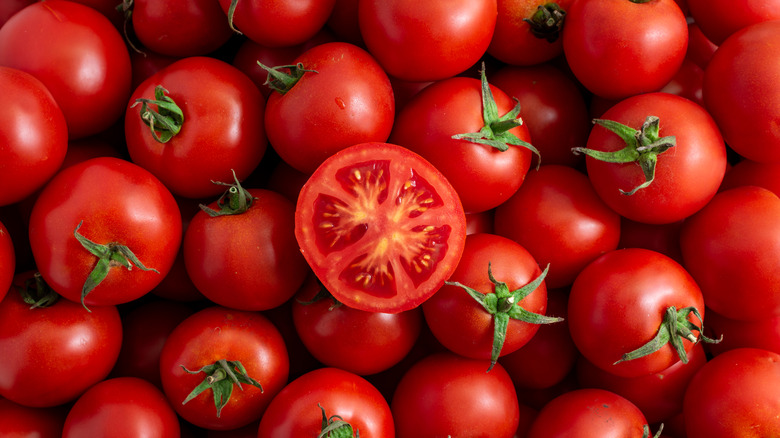The Salting Step You Shouldn't Skip For Better Tasting Tomatoes
Nothing tastes as good as a newly picked, sun-drenched, vine-ripened tomato (fight us), despite the fact that they seem to be less flavorful than in the past. While beefsteaks basically belong on BLTs, and the plum variety is the absolute best for sauces, before eating them, and while cooking with them, there is one step that you should never skip: salting them just enough to draw out the full depth and complexity of that tomato flavor. Food Republic spoke to Dr. Bryan Quoc Le, founder and principal consultant at Mendocino Food Consulting, and he had advice for how to deploy this knowledge.
For raw applications, he explained, "It's best to salt the surfaces of the tomatoes, as the surfaces will be what's most exposed to our taste receptors as the tomatoes are chewed." He suggested using large crystalline salt (like kosher salt) or hollow salt, like Diamond Crystal. The reasoning is that these types dissolve slowly and won't overtake the delicate tomato flavor.
However, Dr. Le told us that salt can be deployed more abundantly when tomatoes are used in a sauce. "The reasoning here is that during the cooking process, the concentration of salt changes as more and more food solids absorb the salt," he said, but you also don't want to overdo it. A good starting ratio is half a teaspoon of salt per 28 ounces of tomatoes. "Most salts work here because you will want the salt to dissolve throughout the mixture," Dr. Le noted.
Why tomatoes need salt like peanut butter needs jelly
Salt improves the flavor of tomatoes in two ways, Dr. Bryan Quoc Le told us. First, salt inhibits bitterness. "Because of the way sodium ions from salt interact with bitter receptors, we perceive bitterness much less sharply than without salt," he said. Salt doesn't actually get in there and zap out the bitterness in the fruit, but it fakes out our taste buds to perceive the more pleasant flavors better. With tomatoes, too, apply a bit of salt, let them sit, and they release juices, some of which might contain a bitter flavor.
Second, according to Dr. Le, tomatoes are chock full of glutamic acid (an amino acid), which is basically what makes our tongues perceive the presence of umami flavor, and it's the same compound that makes up the historically much-maligned MSG seasoning. The inherent sourness of tomatoes obstructs our taste buds from tasting it, but Dr. Le explained, "The combination of sodium from salt and glutamic acid together [is] required to activate umami taste receptors in the mouth." Glutamic acid on its own has only a minor flavor; tomatoes require salt to activate the umami element.


